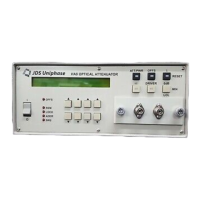Programming Guide – 33
Command Parser Rules
• Commands consist of a mnemonic (for example, WVL) and, if required, a data parameter
(for example, 1300NM). The mnemonic and the parameter must be separated by at least
one space.
• Parameters can be entered in various formats. For example, 1300nm, 1.303-6 mm, and
0.0000013M are recognized as the same value.
• Commands can be sent in uppercase or lowercase characters.
• A command is contained in a message, and messages can contain more than one
command, each one separated by a semicolon (;). For example, WVL 1300NM;
CAL 10dB; ATT 50 dB <CR> <LF> contains three commands.
• All GPIB commands must end with the terminating sequence <CR> <LF> if the active
interface command set is HA9 or HPM.
• All RS232 commands must end with the terminating sequence <CR>.
• The input buffer of the attenuator can hold as many as 100 characters. If the buffer
becomes full, the attenuator holds the handshaking line on the GPIB interface until space
is available. Similarly, over the RS232 interface, the attenuator sets the Clear-To-Send line
low. Any characters received after the line goes low are ignored.
• Commands are executed as they are parsed; consequently, a command can be executed
before the entire message in which it is contained is received.
• The attenuator delays accepting new characters sent over the GPIB interface while the
attenuator mechanism is moving, but no data are lost. The attenuator does not complete
the data exchange handshaking on the bus until the new attenuation is set.
The attenuator is always ready to accept characters over the RS232 interface.
• A query command is used to extract status information from the attenuator. For example,
ATT? <CR> <LF> returns the current attenuation setting.
• The queries ATT?, PWR?, CAL?, PCAL?, and WVL? can include the parameters MIN and
MAX. ATT? MAX, for example, returns the maximum attenuation that can be set at the
current wavelength.
• Query commands in remote operation of the attenuator (via the GPIB or the RS232
interface) results in four digits after the decimal point. However, only the first two digits
after the decimal point are significant; the third and fourth decimal digit must be ignored.
• Multiple-command messages can contain only one query command. A query must be the
last command in the message, for example, ATT 20 dB; ATT? <CR> <LF>.
Artisan Technology Group - Quality Instrumentation ... Guaranteed | (888) 88-SOURCE | www.artisantg.com

